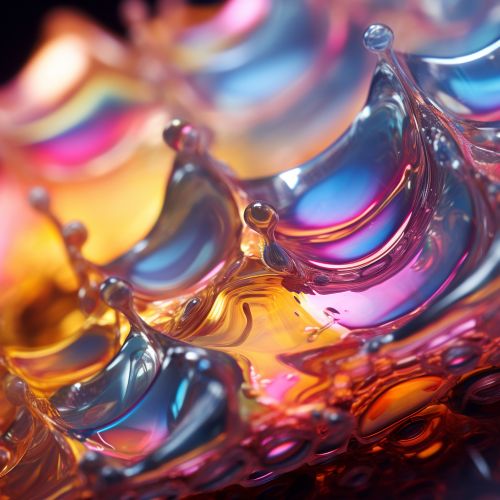The Science of Liquid Crystals and Display Technology
Introduction
Liquid crystals are a state of matter that has properties between those of conventional liquids and those of solid crystals. For instance, a liquid crystal may flow like a liquid, but its molecules may be oriented in a crystal-like way. There are many different types of liquid crystal states, which can be distinguished by their different optical properties. The contrasting areas in the textures correspond to domains where the liquid crystal molecules are oriented in different directions. This can be observed using a polarizing microscope.


History of Liquid Crystals
The study of liquid crystals began in the late 19th century when an Austrian botanist named Friedrich Reinitzer, working at the Charles University in Prague, began studying the behavior of a material known as cholesteryl benzoate. Reinitzer noticed that when he melted this compound, it first became a cloudy liquid and then cleared up as its temperature continued to increase. This dual melting point was peculiar and warranted further investigation.
Structure of Liquid Crystals
Liquid crystals are unique in their structure because they exhibit properties of both liquids and solid crystals. In a liquid state, the material has a disordered structure, meaning the molecules are arranged randomly. In a solid crystal state, the molecules are highly ordered, forming a rigid structure. Liquid crystals, however, have a structure that is somewhat ordered and somewhat disordered. The degree of order can vary depending on the type of liquid crystal.
Types of Liquid Crystals
There are several different types of liquid crystals, including nematic, smectic, and cholesteric (or chiral nematic) liquid crystals. Each of these types has a different degree of order and different properties.
Nematic Liquid Crystals
Nematic liquid crystals are the simplest type of liquid crystal. The molecules in a nematic liquid crystal are oriented in parallel but are not arranged in well-defined planes. The word "nematic" comes from the Greek word νήμα, which means "thread". This refers to the thread-like defects that are observed in nematic liquid crystals.
Smectic Liquid Crystals
Smectic liquid crystals have a greater degree of order than nematic liquid crystals. The molecules in a smectic liquid crystal are oriented in parallel, like in a nematic liquid crystal, but they are also arranged in well-defined planes. The word "smectic" comes from the Greek word σμήγμα, which means "soap".
Cholesteric Liquid Crystals
Cholesteric liquid crystals, also known as chiral nematic liquid crystals, have a structure that is a hybrid of nematic and smectic liquid crystals. The molecules in a cholesteric liquid crystal are oriented in parallel and arranged in well-defined planes, but the direction of alignment rotates slightly from one plane to the next. This rotation creates a helical structure, which gives cholesteric liquid crystals their unique properties.
Liquid Crystal Displays (LCDs)
A liquid crystal display (LCD) is a flat-panel display or other electronically modulated optical device that uses the light-modulating properties of liquid crystals combined with polarizers. Liquid crystals do not emit light directly, instead using a backlight or reflector to produce images in color or monochrome.


Working of LCDs
The basic operation of an LCD is simple to understand. The liquid crystal material is sandwiched between two polarizing filters. When an electric field is applied to the liquid crystal material, the molecules align themselves with the field and change the polarization of the light passing through them. This change in polarization affects the amount of light that can pass through the second polarizing filter, effectively controlling the brightness of the pixel.
Types of LCDs
There are several different types of LCDs, including twisted nematic (TN), in-plane switching (IPS), and vertical alignment (VA) LCDs. Each of these types has different properties and is suited to different applications.
Twisted Nematic (TN) LCDs
Twisted nematic (TN) LCDs are the most common type of LCD. They are inexpensive to produce and have fast response times, making them ideal for applications like computer monitors and televisions. However, they have limited viewing angles and color reproduction.
In-Plane Switching (IPS) LCDs
In-plane switching (IPS) LCDs were developed to overcome the limitations of TN LCDs. They have wider viewing angles and better color reproduction, but they are more expensive to produce and have slower response times.
Vertical Alignment (VA) LCDs
Vertical alignment (VA) LCDs offer a compromise between TN and IPS LCDs. They have better color reproduction and viewing angles than TN LCDs and faster response times than IPS LCDs. However, they are more expensive than TN LCDs and have slower response times than IPS LCDs.
Future of Liquid Crystals and Display Technology
The field of liquid crystals and display technology is constantly evolving. Researchers are continually developing new types of liquid crystals and improving the performance of LCDs. In addition, new display technologies, such as organic light-emitting diode (OLED) displays and quantum dot displays, are being developed. These new technologies promise to deliver better performance and new features, but they also present new challenges that must be overcome.
